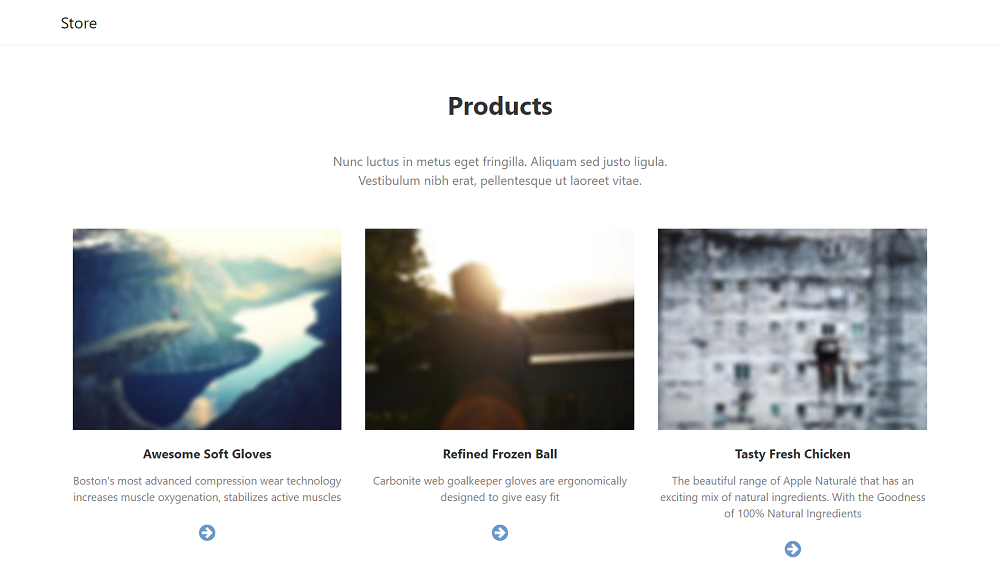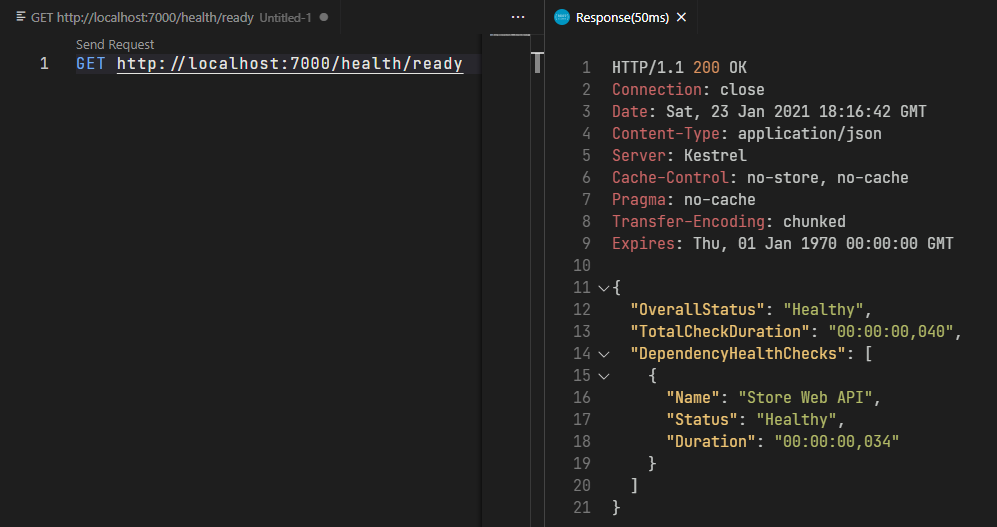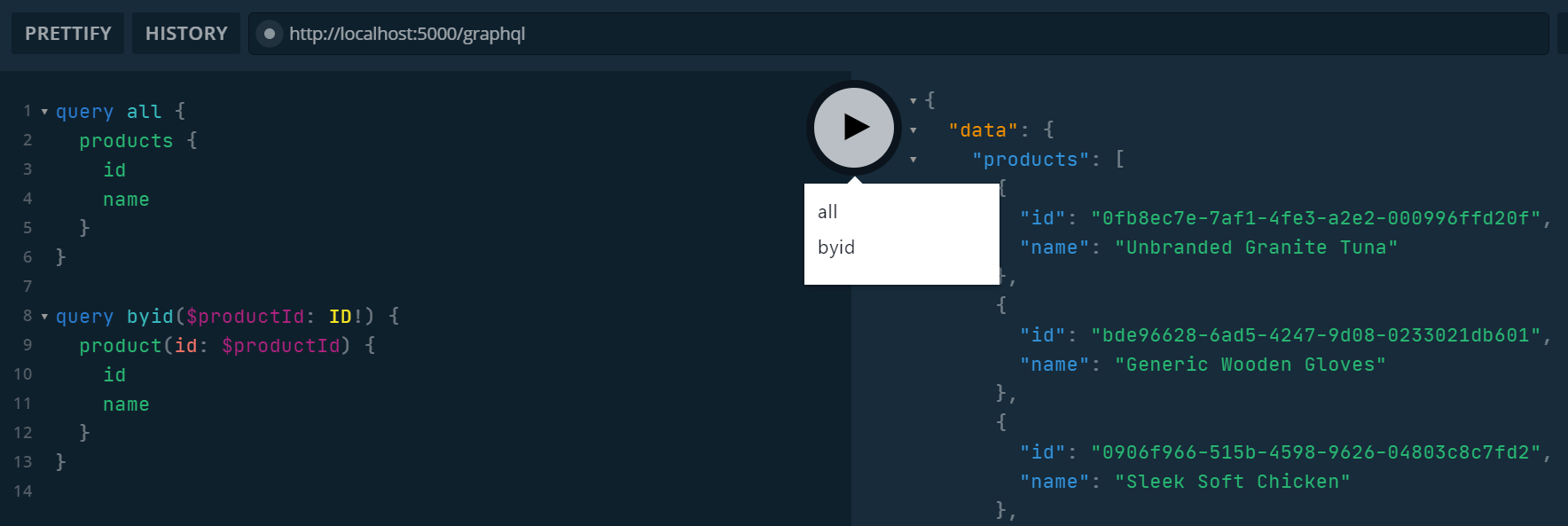This project exemplifies the implementation and dockerization of a simple Razor Web MVC Core consuming a full GraphQL 4 Web API, build in a .NET 6 multi-layer project, considering development best practices, like SOLID, KISS and DRY, applying Domain-Driven concepts in a Hexagonal Architecture.
| WebAPI |
|---|
 |
| WebMVC |
 |
Oldest version: Dotnet5.GraphQL3.WebApplication
| WebAPI |  |
|---|---|
| WebMVC |  |
To configure database resource, init secrets in ./src/Dotnet6.GraphQL4.Store.WebAPI, and then define the DefaultConnection:
dotnet user-secrets init
dotnet user-secrets set "ConnectionStrings:DefaultConnection" "Server=localhost,1433;Database=Store;User=sa;Password=!MyComplexPassword"After this, to configure the HTTP client, init secrets in ./src/Dotnet6.GraphQL4.Store.WebMVC and define Store client host:
dotnet user-secrets init
dotnet user-secrets set "HttpClient:Store" "http://localhost:5000"If you prefer, is possible to define it on WebAPI appsettings.Development.json and WebMVC appsettings.Development.json files:
WebAPI
{
"ConnectionStrings": {
"DefaultConnection": "Server=localhost,1433;Database=Store;User=sa;Password=!MyComplexPassword"
}
}WebMCV
{
"HttpClient": {
"Store": "http://localhost:5000"
}
}Considering use Docker for CD (Continuous Deployment). On respective compose both web applications and sql server are in the same network, and then we can use named hosts. Already defined on WebAPI appsettings.json and WebMVC appsettings.json files:
WebAPI
{
"ConnectionStrings": {
"DefaultConnection": "Server=mssql;Database=Store;User=sa;Password=!MyComplexPassword"
}
}WebMCV
{
"HttpClient": {
"Store": "http://webapi:5000"
}
}The ./docker-compose.yml provide the WebAPI, WebMVC and MS SQL Server applications:
docker-compose up -dIt's possible to run without a clone of the project using the respective compose:
version: "3.7"
services:
mssql:
container_name: mssql
image: mcr.microsoft.com/mssql/server
ports:
- 1433:1433
environment:
SA_PASSWORD: "!MyComplexPassword"
ACCEPT_EULA: "Y"
healthcheck:
test: /opt/mssql-tools/bin/sqlcmd -S localhost -U sa -P "$$SA_PASSWORD" -Q "SELECT 1" || exit 1
interval: 10s
timeout: 3s
retries: 10
start_period: 10s
networks:
- graphqlstore
webapi:
container_name: webapi
image: antoniofalcaojr/dotnet6-graphql4-webapi
environment:
- ASPNETCORE_URLS=http://*:5000
ports:
- 5000:5000
depends_on:
mssql:
condition: service_healthy
networks:
- graphqlstore
webmvc:
container_name: webmvc
image: antoniofalcaojr/dotnet6-graphql4-webmvc
environment:
- ASPNETCORE_URLS=http://*:7000
ports:
- 7000:7000
depends_on:
- webapi
networks:
- graphqlstore
healthchecks:
container_name: healthchecks-ui
image: xabarilcoding/healthchecksui
depends_on:
mssql:
condition: service_healthy
environment:
- storage_provider=SqlServer
- storage_connection=Server=mssql;Database=Store;User=sa;Password=!MyComplexPassword
- Logging:LogLevel:Default=Debug
- Logging:Loglevel:Microsoft=Warning
- Logging:LogLevel:HealthChecks=Debug
- HealthChecksUI:HealthChecks:0:Name=webapi
- HealthChecksUI:HealthChecks:0:Uri=http://webapi:5000/healthz
- HealthChecksUI:HealthChecks:1:Name=webmvc
- HealthChecksUI:HealthChecks:1:Uri=http://webmvc:7000/healthz
ports:
- 8000:80
networks:
- graphqlstore
networks:
graphqlstore:
driver: bridgeBy default Playground respond at http://localhost:5000/ui/playground but is possible configure the host and many others details in ../DependencyInjection/Extensions/ApplicationBuilderExtensions.cs
app.UseGraphQLPlayground(
options: new()
{
BetaUpdates = true,
RequestCredentials = RequestCredentials.Omit,
HideTracingResponse = false,
EditorCursorShape = EditorCursorShape.Line,
EditorTheme = EditorTheme.Dark,
EditorFontSize = 14,
EditorReuseHeaders = true,
EditorFontFamily = "JetBrains Mono"
},
path: "/ui/playground");Based on cloud-native concepts, Readiness and Liveness integrity verification strategies were implemented.
/health
Just check if the instance is running.
/health/live
Check if the instance is running and all the dependencies too.
/health/ready
Check if the instance and all the dependencies are ready to attend to all functionalities.
Web API
http://localhost:5000/health/ready
{
"status": "Healthy",
"totalDuration": "00:00:00.2344435",
"entries": {
"Sql Server (Ready)": {
"data": {},
"duration": "00:00:00.2251420",
"status": "Healthy",
"tags": [
"ready"
]
}
}
}Web MVC
http://localhost:7000/health/ready
It is possible to dump the state of the environment configuration in through the middleware resource /dump-config in both applications.
public void Configure(IApplicationBuilder app)
{
app.UseEndpoints(endpoints =>
{
endpoints.MapDumpConfig(
pattern: "/dump-config",
configurationRoot: _configuration as IConfigurationRoot,
isProduction: _env.IsProduction());
});
}The implementation of the UnitOfWork gives support to the ExecutionStrategy from EF Core with TransactionScope.
operationAsync: Encapsulates all desired transactions;
condition: External control for commitment;
cancellationToken: The cancellation token to be used within operation.
public Task<Review> AddReviewAsync(ReviewModel reviewModel, CancellationToken cancellationToken)
{
return UnitOfWork.ExecuteInTransactionScopeAsync(
operationAsync: async ct =>
{
var product = await Repository.GetByIdAsync(
id: reviewModel.ProductId,
include: products => products.Include(x => x.Reviews),
asTracking: true,
cancellationToken: ct);
var review = Mapper.Map<Review>(reviewModel);
product?.AddReview(review);
await OnEditAsync(product, ct);
return review;
},
condition: _ => NotificationContext.AllValidAsync,
cancellationToken: cancellationToken);
}To avoid handle exceptions, was implemented a NotificationContext that's allow all layers add business notifications through the request, with support to receive Domain notifications, that by other side, implementing validators from Fluent Validation and return a ValidationResult.
protected bool OnValidate<TEntity>(TEntity entity, AbstractValidator<TEntity> validator)
{
ValidationResult = validator.Validate(entity);
return IsValid;
}
protected void AddError(string errorMessage, ValidationResult validationResult = default)
{
ValidationResult.Errors.Add(new ValidationFailure(default, errorMessage));
validationResult?.Errors.ToList().ForEach(failure => ValidationResult.Errors.Add(failure));
}To the GraphQL the notification context delivery a ExecutionErrors that is propagated to result from execution by a personalised Executer:
public override async Task<ExecutionResult> ExecuteAsync(string operationName, string query, Inputs variables, IDictionary<string, object> context, IServiceProvider requestServices, CancellationToken cancellationToken = new CancellationToken())
{
var result = await base.ExecuteAsync(operationName, query, variables, context, requestServices, cancellationToken);
var notification = requestServices.GetRequiredService<INotificationContext>();
if (notification.HasNotifications is false) return result;
result.Errors = notification.ExecutionErrors;
result.Data = default;
return result;
}It's no more necessary after version 4.2.0 from GraphQL Server. By default, the Service Provider is already being propagated.
Is necessary, in the same personalised Executer define the service provider that will be used from resolvers on fields:
var options = base.GetOptions(operationName, query, variables, context, cancellationToken);
options.RequestServices = _serviceProvider;With abstract designs, it is possible to reduce coupling in addition to applying DRY concepts, providing resources for the main behaviors:
public abstract class Entity<TId>
where TId : structpublic abstract class Builder<TBuilder, TEntity, TId> : IBuilder<TEntity, TId>
where TBuilder : Builder<TBuilder, TEntity, TId>
where TEntity : Entity<TId>
where TId : structpublic abstract class Repository<TEntity, TId> : IRepository<TEntity, TId>
where TEntity : Entity<TId>
where TId : struct
{
private readonly DbSet<TEntity> _dbSet;
protected Repository(DbContext dbDbContext)
{
_dbSet = dbDbContext.Set<TEntity>();
}public abstract class Service<TEntity, TModel, TId> : IService<TEntity, TModel, TId>
where TEntity : Entity<TId>
where TModel : Model<TId>
where TId : struct
{
protected readonly IMapper Mapper;
protected readonly INotificationContext NotificationContext;
protected readonly IRepository<TEntity, TId> Repository;
protected readonly IUnitOfWork UnitOfWork;
protected Service(
IUnitOfWork unitOfWork,
IRepository<TEntity, TId> repository,
IMapper mapper,
INotificationContext notificationContext)
{
UnitOfWork = unitOfWork;
Repository = repository;
Mapper = mapper;
NotificationContext = notificationContext;
}public abstract class MessageService<TMessage, TModel, TId> : IMessageService<TMessage, TModel, TId>
where TMessage : class
where TModel : Model<TId>
where TId : struct
{
private readonly IMapper _mapper;
private readonly ISubject<TMessage> _subject;
protected MessageService(IMapper mapper, ISubject<TMessage> subject)
{
_mapper = mapper;
_subject = subject;
}ENTITY
public class ProductConfig : IEntityTypeConfiguration<Product>
{
public void Configure(EntityTypeBuilder<Product> builder)
{
builder
.HasDiscriminator()
.HasValue<Boot>(nameof(Boot))
.HasValue<Kayak>(nameof(Kayak))
.HasValue<Backpack>(nameof(Backpack));
}
}INHERITOR
public class KayakConfig : IEntityTypeConfiguration<Kayak>
{
public void Configure(EntityTypeBuilder<Kayak> builder)
{
builder
.HasBaseType<Product>();
}
}INTERFACE
public sealed class ProductInterfaceGraphType : InterfaceGraphType<Product>
{
public ProductInterfaceGraphType(BootGraphType bootGraphType, BackpackGraphType backpackGraphType, KayakGraphType kayakGraphType)
{
Name = "product";
ResolveType = @object =>
{
return @object switch
{
Boot _ => bootGraphType,
Backpack _ => backpackGraphType,
Kayak _ => kayakGraphType,
_ => default
};
};
}
}OBJECT
public sealed class KayakGraphType : ObjectGraphType<Kayak>
{
public KayakGraphType()
{
Name = "kayak";
Interface<ProductInterfaceGraphType>();
IsTypeOf = o => o is Product;
}
}QUERY
{
First: product(id: "2c05b59b-8fb3-4cba-8698-01d55a0284e5") {
...comparisonFields
}
Second: product(id: "65af82e8-27f6-44f3-af4a-029b73f14530") {
...comparisonFields
}
}
fragment comparisonFields on product {
id
name
rating
description
}RESULT
{
"data": {
"First": {
"id": "2c05b59b-8fb3-4cba-8698-01d55a0284e5",
"name": "libero",
"rating": 5,
"description": "Deleniti voluptas quidem accusamus est debitis quisquam enim."
},
"Second": {
"id": "65af82e8-27f6-44f3-af4a-029b73f14530",
"name": "debitis",
"rating": 10,
"description": "Est veniam unde."
}
}
}QUERY
query all {
products {
items {
id
name
}
}
}
query byid($productId: Guid!) {
product(id: $productId) {
id
name
}
}VARIABLES
{
"productId": "2c05b59b-8fb3-4cba-8698-01d55a0284e5"
}HTTP BODY
{
"operationName": "byid",
"variables": {
"productId": "2c05b59b-8fb3-4cba-8698-01d55a0284e5"
},
"query": "query all {
products {
items {
id
name
}
}
}
query byid($productId: Guid!) {
product(id: $productId) {
id
name
}
}"
}PLAYGROUND
QUERY
query all($showPrice: Boolean = false) {
products {
items {
id
name
price @include(if: $showPrice)
rating @skip(if: $showPrice)
}
}
}VARIABLES
{
"showPrice": true
}HTTP BODY
{
"operationName": "all",
"variables": {
"showPrice": false
},
"query": "query all($showPrice: Boolean = false) {
products {
items {
id
name
price @include(if: $showPrice)
rating @skip(if: $showPrice)
}
}
}"
}QUERY
{
products(pageParams: { index: 2, size: 1 }) {
items {
id
}
pageInfo {
current
hasNext
hasPrevious
size
}
}
}RESULT
{
"data": {
"products": {
"items": [
{
"id": "3b2f6ce4-1b1d-4376-80a6-0b8d51932757"
}
],
"pageInfo": {
"current": 2,
"hasNext": true,
"hasPrevious": true,
"size": 1
}
}
}
}MUTATION
Creating / adding a new Review to the respective product.
mutation($review: reviewInput!) {
createReview(review: $review) {
id
}
}VARIABLES
{
"review": {
"title": "some title",
"comment": "some comment",
"productId": "0fb8ec7e-7af1-4fe3-a2e2-000996ffd20f"
}
}RESULT
{
"data": {
"createReview": {
"title": "some title"
}
}
}SUBSCRIPTION
The Mutation stay listening if a new review is added.
subscription {
reviewAdded {
title
}
}
RESULT
{
"data": {
"reviewAdded": {
"title": "Some title"
}
}
}- .NET 6 - Base framework;
- ASP.NET 6 - Web framework;
- Entity Framework Core 6 - ORM;
- Microsoft SQL Server on Linux for Docker - Database.
- GraphQL - GraphQL is a query language for APIs and a runtime for fulfilling those queries with data;
- GraphQL for .NET - This is an implementation of GraphQL in .NET;
- GraphQL Client - A GraphQL Client for .NET over HTTP;
- GraphQL Playground - GraphQL IDE for better development workflows.
- AutoMapper - A convention-based object-object mapper;
- FluentValidation - A popular .NET library for building strongly-typed validation rules;
- Bogus - A simple and sane fake data generator for C#, F#, and VB.NET;
- Bootstrap - The most popular HTML, CSS, and JS library in the world.
- Serilog - Serilog provides diagnostic logging to files, the console, and elsewhere.
All contributions are welcome. Please take a look at contributing guide.
We use SemVer for versioning. For the versions available, see the tags on this repository.
See the list of contributors who participated in this project.
This project is licensed under the MIT License - see the LICENSE file for details



